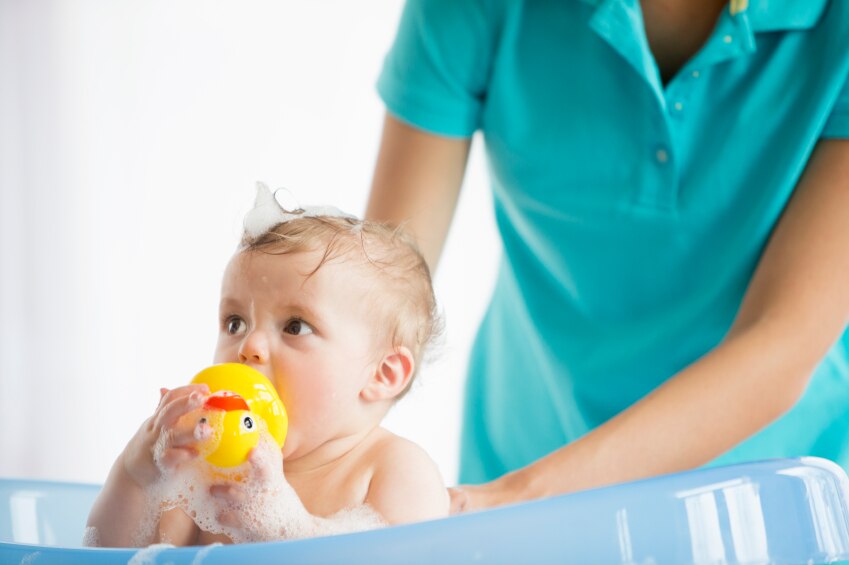Nothing is safe—or sacred—anymore, not even the ubiquitous rubber ducky. In fact, good ole rubber ducky could be the poster child of one of the most disturbing dangers in kids toys—soft flexible plastic, riddled with hormone-disrupting phthalates.
Although awareness about toxins in toys is growing, and laws like the Consumer Product Safety Improvement Act of 2008 are making testing for toys more stringent, rules regarding the wild proliferation of chemicals in toys remains on the loosey-goosey side.
“The biggest problem with toxins in toys is that they are there at all,” says Margie Kelly, communications manager for the organization Healthy Child Healthy World. “Products for children should not be a hazard; they should be safe.”
More than 80,000 chemicals go into the manufacturing process in a factory, and safety data exists only for 15 percent of the new chemicals submitted to the EPA for approval. Adding insult to injury, many of the older chemicals don’t require any safety testing. The result? A chemical brew of suspect substances that our children are sinking their teeth into. And it starts young. Hundreds of chemicals have been found in the cord blood of newborns, as well in breast milk, including the following:
- Bisphenol A (BPA, found in hard plastics)
- Polybrominated diphenyl ethers (PBDEs, which are flame retardants)
- Perchlorate (rocket fuel)
- Perfluorinated chemicals (PFCs, like those used in nonstick pans)
- Phthalates (plastic softeners)
- Polyvinyl chloride (PVC, commonly known as vinyl)
- Heavy metals like cadmium, lead and mercury
Children are the most vulnerable to this chemical onslaught for a variety of reasons. Their organs continue developing through adolescence. They play close to the ground where they can absorb chemicals through their skin. Finally, young children tend to put the toys in their mouths, where they ingest chemicals not meant for consumption. Because of their rapid growth, children breathe more air, consume more food and drink more water than adults. Diseases that show up in children as a result of potential environmental exposures include certain birth defects, asthma, certain childhood cancers and ADHD.
While you don’t want to throw the proverbial baby out with the bath toys, here are four of the most fearsome toxins to avoid:
Phthalates/PVC
What they do: The polyvinyl chloride (PVC) plastic industry uses large amounts of phthalates as additives to improve the flexibility of products. “Vinyl should not be allowed in our homes,” warns Kelly. “It’s dangerous throughout its life cycle and never breaks down.” Phthalates are also fragrance-stabilizers used in many skincare products and perfumes, including those targeted at babies. Many studies link phthalates with hormone disruption that may result in genetic abnormality, reduced sperm counts for men, and breast and liver cancers.
Found in: Toys made from squishy plastic (sorry ducky) or toys that include a highly flexible plastic as a component, such as the clear plastic pages of a child’s photo album. If you’re not sure, call the manufacturer to ask what a toy is made from.
Bisphenol-A (BPA)
What it does: Another endocrine disruptor, BPA has been linked by an impressive body of research to a variety of issues, including developmental and brain effects in infants, cancer, sexual dysfunction, obesity and heart disease. Particularly troubling is BPA’s effect on the development of fetuses, infants and young children.
Found in: Awareness of the effects of BPA has made major inroads in parents’ consciousness, and many toys now proudly advertise themselves as BPA free. Often consumers think BPA is found only in hard, clear plastic, such as baby bottles, but it can also be present in opaque plastic as well. If the product has the plastic recycling number 7, chances are it contains BPA.
Flame retardant
What it does: Numerous studies have linked polybrominated diphenyl ethers (PBDEs)—used to make children’s sleepwear, bedding and car seats, as well as everything from sofas to TVs more flame resistant—to harmful liver, thyroid, reproductive/developmental and neurological effects. Most of these chemicals have already been banned in the European Union. Such flame retardants compensate for the inherent flammability of the synthetic materials in use. On the other hand, natural textiles and fillers are inherently less flammable and make for a less toxic alternative.
Testing done by the Environmental Working Group in 2008 showed that American children have much higher levels of PBDEs in their blood than their parents. In fact, young children in the United States bear some of the heaviest burdens of flame retardant pollution in the industrialized world.
Found in: Nursing pillows, mattresses, strollers, high chairs, furniture, plush toys, stuffed toys, computers and TVs.
Lead/cadmium
What it does: Invisible to the eye, lead can cause IQ deficits, attention deficit hyperactivity disorder and problems with vocabulary, fine motor skills, reaction time and hand-eye coordination. Lead is especially harmful to the brains of young children, according to “Trouble in Toyland,” the 2011 report by the United States Public Interest Research Group.
Cadmium has the same health effects as lead. In addition to the fact that it can cause kidney problems and bone loss, some studies show a link to kidney and prostate cancers. The good news? According to the organization HealthyStuff, the number of toys they’ve tested that exceed federal lead limits has actually decreased by two-thirds since 2007.
Found in: Lead, widely used in other countries such as China, can be found in imported toys. A common source of lead is lead-based paint, so check to see the toy’s country of origin and look for indicators that paint and finishes are nontoxic. Lead is also used to soften plastic and make it more flexible. Other kids’ products that may include lead and/or cadmium (cadmium usually shows up in yellow, orange or red pigments) are jewelry, metal toys and lunch bags.
Click this link for a checklist on how to choose safer toys.

